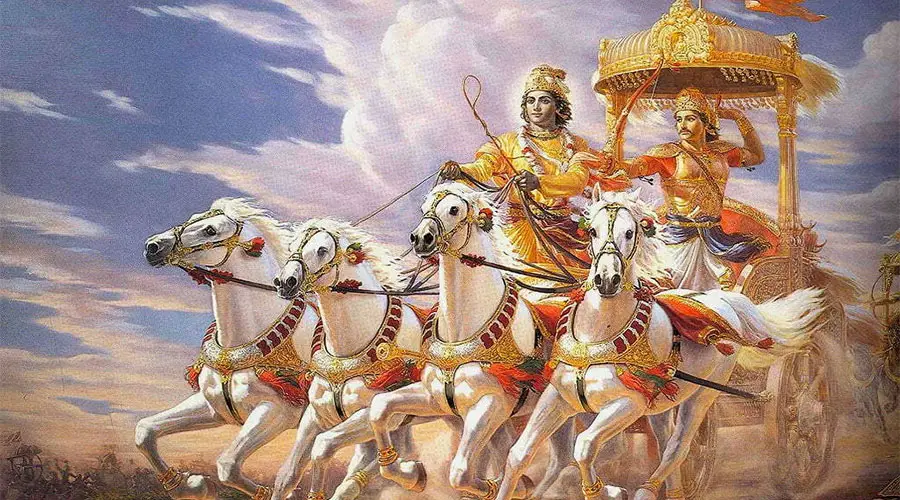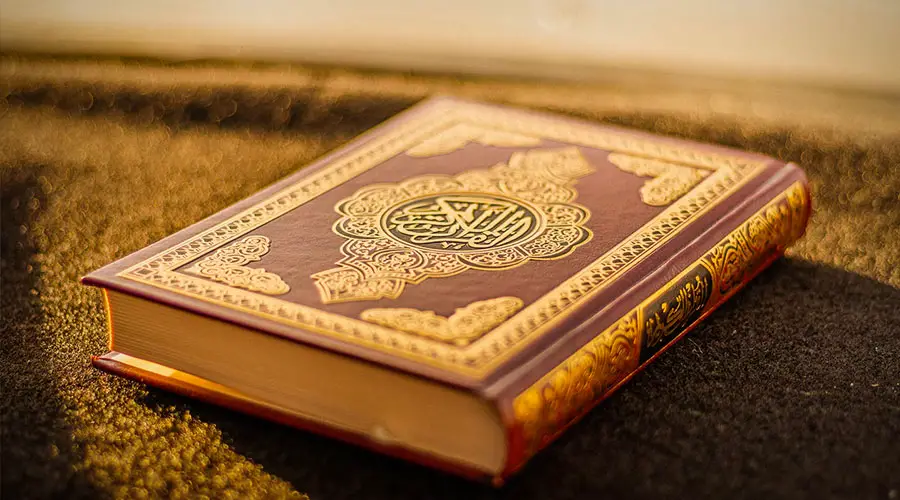A key feature amongst many of the world’s most popular religions is a holy book or group of books that contain the sacred teachings of the religion. Like Christianity, Hinduism also has such a book, which its believers turn to for guidance and wisdom.
In Hinduism, the Bhagavad Gita is the closest equivalent to the Bible, as it is considered authoritative and provides a guide on how to live for those who adhere to its teachings. It is but one book in a group of holy books in Hinduism, called the Vedas, which were written in 1200 BC – 100 BC.

What is the main message of the Bhagavad Gita?
The Bhagavad Gita means Song of God, and describes the ancient spiritual wisdom of India. It is written in the form of a dialogue between Prince Arjuna and Krishna, a deity in Hinduism. The dialogue occurs amidst a major battle between rival factions of the royal family. Arjuna feels remorse for being a part of so much bloodshed, which saw the death of many friends and family members. Krishna responds to Arjuna, and the message is the central theme in the Bhagavad Gita. Arjuna is advised by Krishna to accept his duties as powerful noble, and fight.
The Bhagavad Gita makes distinctions between the body and soul, and describes how only the body can be killed, while the soul is eternal. The book also discusses the concept of karma, which is the approach to life of taking good actions, knowing that your actions towards others effects your own fate, as well as nirvana, which is Sanskrit for “becoming extinguished” and is a state of bliss that meditation practices seek to achieve.
Understanding Lord Krishna
In Hinduism, Lord Krishna is considered the Supreme God, as well as the 8th avatar of Vishnu. Widely worshipped and beloved by Hindus, he is the god of love, compassion, and protection. Each year Hindus celebrate his birthday, and he is the central character in the Bhagavad Gita, as well as several other holy texts. He is depicted with blue skin, and in many different forms, such as a baby eating butter, a young boy who plays the flute, a young deity surrounded by women devotees, or in the case of the Bhagavad Gita, a charioteer discussing the war, and giving advice to Arjuna.
The Five Topics of the Bhagavad Gita
In Hinduism the Bhagavad Gita is considered to have been spoken by Sri Krishna the Supreme Personality of Godhead to his disciple Sri Arjuna. And that the following five principles come from God himself.
Ishvara – The Supreme Personality of Godhead
The Supreme Lord, considered the source of everything in existence. Nothing in creation is created by itself, but rather is the result of something else. Ultimately everything comes from the same source, which in the Bhagavad Gita is called Ishvara.
Jiva – The Individual Soul
Jiva is considered merely a part of Ishvara, rather than being separate. Jiva can be trapped by the material world, or can be spiritually aware, in a state of Krishna consciousness.
Prakruti – Material Nature
Material nature, known as Prakruti in Hinduism, is separated energy from the Supreme Lord. However, material nature is still under the authority of the Supreme Lord
Kala – Eternal time
The process of time is known in Hinduism as Kala, and it eventually destroys anything that is not eternal. For example, the objects we create, and even the bodies we live in are eventually all destroyed by time.
Karma – All kinds of Activities
The experience of living in this world means that we are constantly involved in creating actions, as well as reacting to the actions of others. The sum total of all these dynamics is called Karma. This means that we are suffering from and enjoying the results of our past actions, while creating more to come in the future.
Vyasa: The Original Writer of the Bhagavad Gita
According to Indian tradition, the Bhagavad Gita was authored by a sage named Vyasa. He is considered a mythical author, and part of legend, and is also known as Krishna Dvaipayana, or Veda-Vyasa. One legend describes Vyasa narrating the book while the lord Ganesha breaks one of his tusks and writing the down the Bhagavad Gita.
The name Vyasa is Sanksrit for “compiler” or “arranger”, and he is also the author of the Mahabharata, a collection of heroic poetry. According to legend he was the son of an ascetic monk, which is the practice of self-denial as a measure of discipline, and an Aboriginal princess. He grew up in the forest and was taught the Vedas by hermits. He grew up to become a priest and teacher, with a large following of disciples. Later in life, he lived in a cave and while immersed in the Vedas, composed his masterpieces of poetry.
Other Holy Books of Hinduism
The Bhagavad Gita is one book in a series of holy books, called the Vedas. They were written in 1200 – 100 BC and introduced to India by the Aryans, an invading group who conquered Iran and India and shaped Indian culture and philosophy. The Vedas are made up of four compositions, which each contain four subsections.
The Samhitas are the oldest part of the Vedas, and contain hymns to praise God. The Samhitas consists of the following four parts:
- Rig-Veda Samhita is the oldest of the four Vedas and contains hymns for praising the gods.
- Yajur-Veda Samhita is a reference book for priests who perform the Vedic sacrifices.
- Sama-Veda Samhita contains chants and songs to be sung during sacrifices.
- Atharva-Veda Samhita is about traditions from before the Aryan invasion, including spells and charms.
The Brahmanas are about the rituals and prayers for the priests of Hinduism. The name Brahmanas means the utterance of a Brahman priest. This portion of the Vedas comes from a time when gathering and organizing the sacred hymns was given priority by the priests.
The Aranyakas is concerned with ritual sacrifice. A latter addition to the Vedas, they were initially intended only for those who were initiated and considered ready for this knowledge. It discusses the deeper meaning of the ritual sacrifices.
The Upanishads deals with meditation and philosophy. Originally written in 800 BC, additional texts were continually added to it until 16th century AD. The name refers to those who sit near the teacher, and the text deals with the concept of Brahman, which is the creative force which informs reality.
The Vedas play a similar role as the Bible to members of the Hindu faith, as they are the sacred texts which contain the knowledge of the religion. Believers turn to it for knowledge on how to conduct their lives, as well as hymns which can be sung to worship. Next, we are going to look at how the Bible became the sacred book of Christianity, and a metaphor for the primary, most authoritative book on any subject.

How did the Bible Become the Bible?
Similar to the Vedas, it is believed that the Bible comes from oral traditions which were eventually written down. The Bible is considered by many to be the single most influential work of literature of all time, shaping entertainment and culture. There is mystery surrounding the origins of the Bible, but it is believed that the Old Testament was written sometime between 1200 and 165 BC. It is very similar to the Jewish Bible. Later, around 80-100 AD, the New Testament, the other half of the Bible was written.
The Difference Between the Old Testament and New Testament?
There are two halves to the Bible, with the Old Testament describing the journey of the Jews a millennium before the birth of Jesus, and the New Testament is about the life and teachings of Jesus.
In the Old Testament, the creation of Earth through Noah and the flood is described. the Israelites escape their slavery in Egypt, making their way to the promised land. The Old Testament contains four parts: the Pentateuch, the Former Prophets, the Writings, and the Latter Prophets. Authorship of parts of the Old Testament is attributed to Moses, the Hebrew leader and prophet who led the Israelites out of slavery in Egypt.
The New Testament is seen as the fulfillment of the promise of the Messiah of the Old Testament. It describes the new covenant between God and the followers of Christ, represented in the life and death of Jesus. Much of the New Testament is attributed to Paul the Apostle, who converted to Christianity after meeting Jesus on the road to Damascus.
Moses: The Author of the Old Testament
Considered the most important Jewish prophet, he is considered the author of the Torah by Jews, and led the Israelites out of Egypt across the Red Sea and away from slavery. The ten commandments were revealed to Moses on Mount Sinai, and he is also the founder of the religious community Israel.
The New Testament is seen as the fulfillment of the promise of the Messiah of the Old Testament. It describes the new covenant between God and the followers of Christ, represented in the life and death of Jesus. Much of the New Testament is attributed to Paul the Apostle, who converted to Christianity after meeting Jesus on the road to Damascus.
The Writings of St. Paul the Apostle
Regarded as the author of the New Testament, he is sometimes referred to as the second most important person in Christianity after Jesus. He was one of the leaders of the early Christians, he had a group of followers, as well as enemies. Of 27 books in the New Testament, 13 are attributed to Paul. Another portion of the Bible describes the story of Paul’s life.
The Holy Book of Judaism
In Judaism, there is the Torah, which contains five holy books, including Genesis, Exodus, Leviticus, Numbers, and Deuteronomy. These books are also contained in the Old Testament, though Christianity adds additional books to its holy book, while Judaism sticks to the original five described above.
The Holy Book of Islam
The third of the three great monotheistic religions, Islam appeared later in history than Christianity and Judaism. In Islam, the Quran is the holy book, believed by Muslims to be the revelation of God. It consists of 114 chapters and is also considered a masterpiece of Arabic literature, greatly influencing the language. It is believed that the Quran was revealed to the prophet Mohammad through the archangel Gabriel over a period of twenty-three years, beginning in the year 610 AD. The book was written by companions of Mohammad who worked as his scribes.

Holy Books in Buddhism
In Buddhism, there are three holy books: The Tripitaka, Mahayana Sutras and the Tibetan Book of the Dead.
The Tripitaka
Contains the words of Buddha, and teachings for monks, its name means “Triple Basket”.
Mahayana Sutras
Discusses transcendent wisdom, as well as the path of the bodhisattva, and transcendent virtues.
the Tibetan Book of the Dead
Contains profound insights in the process of life and death, the cycle of reincarnation, and the method to which a soul can become liberated from the cycle.
Recommended Reading
If you want to continue exploring this subject more deeply, you can see which books I recommend by clicking here.
